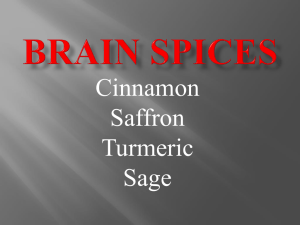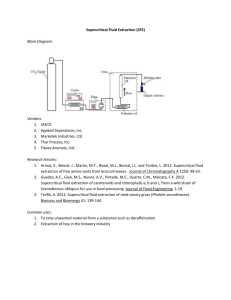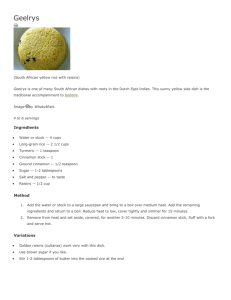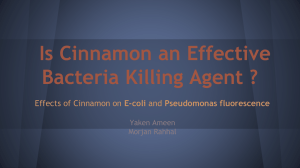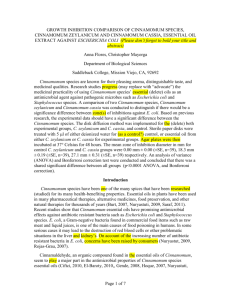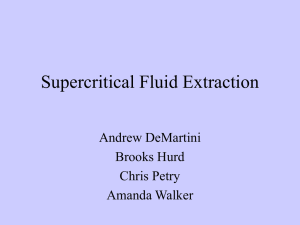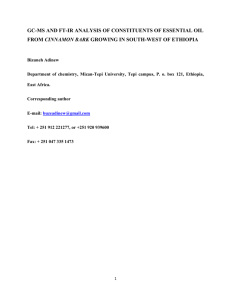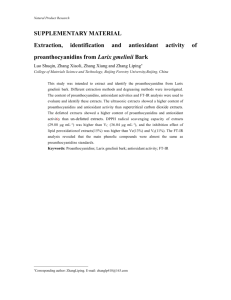Bioanalytical evaluation of Cinnamomum zeylanicum
advertisement
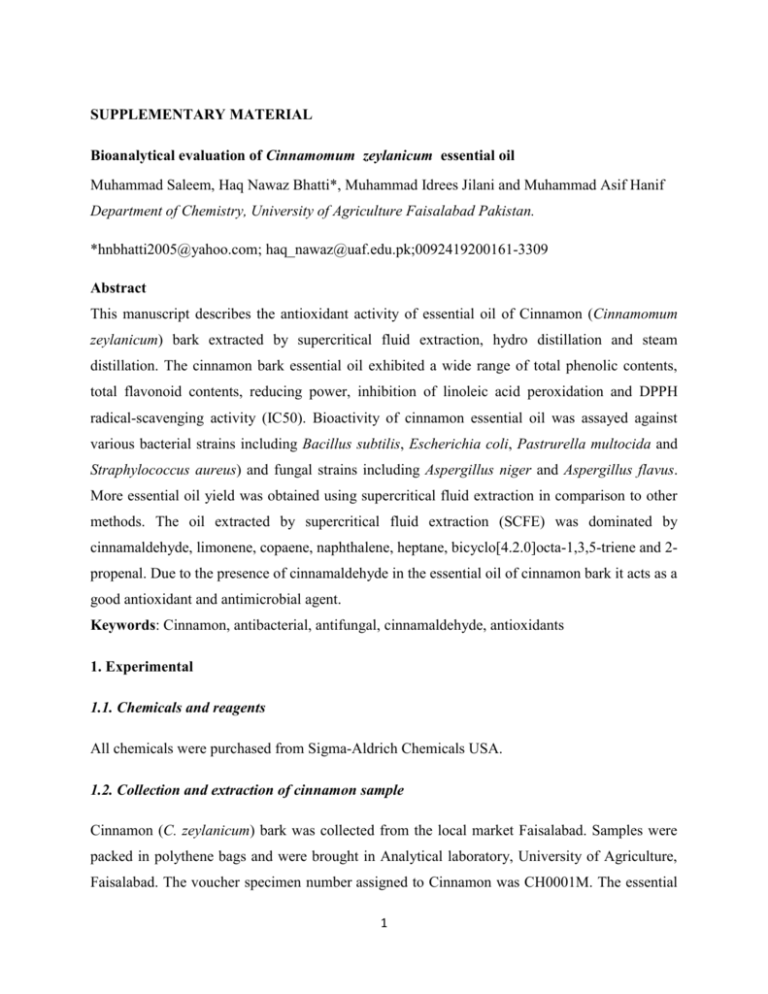
SUPPLEMENTARY MATERIAL Bioanalytical evaluation of Cinnamomum zeylanicum essential oil Muhammad Saleem, Haq Nawaz Bhatti*, Muhammad Idrees Jilani and Muhammad Asif Hanif Department of Chemistry, University of Agriculture Faisalabad Pakistan. *hnbhatti2005@yahoo.com; haq_nawaz@uaf.edu.pk;0092419200161-3309 Abstract This manuscript describes the antioxidant activity of essential oil of Cinnamon (Cinnamomum zeylanicum) bark extracted by supercritical fluid extraction, hydro distillation and steam distillation. The cinnamon bark essential oil exhibited a wide range of total phenolic contents, total flavonoid contents, reducing power, inhibition of linoleic acid peroxidation and DPPH radical-scavenging activity (IC50). Bioactivity of cinnamon essential oil was assayed against various bacterial strains including Bacillus subtilis, Escherichia coli, Pastrurella multocida and Straphylococcus aureus) and fungal strains including Aspergillus niger and Aspergillus flavus. More essential oil yield was obtained using supercritical fluid extraction in comparison to other methods. The oil extracted by supercritical fluid extraction (SCFE) was dominated by cinnamaldehyde, limonene, copaene, naphthalene, heptane, bicyclo[4.2.0]octa-1,3,5-triene and 2propenal. Due to the presence of cinnamaldehyde in the essential oil of cinnamon bark it acts as a good antioxidant and antimicrobial agent. Keywords: Cinnamon, antibacterial, antifungal, cinnamaldehyde, antioxidants 1. Experimental 1.1. Chemicals and reagents All chemicals were purchased from Sigma-Aldrich Chemicals USA. 1.2. Collection and extraction of cinnamon sample Cinnamon (C. zeylanicum) bark was collected from the local market Faisalabad. Samples were packed in polythene bags and were brought in Analytical laboratory, University of Agriculture, Faisalabad. The voucher specimen number assigned to Cinnamon was CH0001M. The essential 1 oil from cinnamon bark was extracted by hydro-distillation, steam distillation and supercritical fluid extraction methods. The extracted essential oil was stored in sealed vials at 4°C, until to further analyses (Wang et al. 2009). Five kilo grams of the C. zeylanicum bark was hydro distilled for 3 h in Clevenger type apparatus. Five kilo grams of the C. zeylanicum bark was steam distilled for 3 h in Clevenger type apparatus. Heat was supplied to the heating mantle (120 oC) and the essential oil was extracted for 3 h (until no more essential oil was recovered). The essential oil was collected and analyzed immediately. Ten kilograms of C. zeylanicum bark was used to extract the essential oils using supercritical CO2 extraction at 45˚C and 90 bar pressure for a batch time of 4h. 1.3. Gas chromatographic/mass spectrometry analysis The components of essential oil extracted from cinnamon bark were analyzed using GC-MS analysis (Hussain et al. 2013, Lohani et al. 2012). The analysis of the oils was performed using a gas chromatograph (HP 6890N Network CG System) with a capillary column HP-5 (30 m × 0.32 mm×0.25 µm film thickness) and a flow of 0.5 mL min−1 in 1:20 split ratio mode (split injector; 290 °C). The oven temperature was programmed to increase from 70 °C (held for 5 min) to 250 °C at 3 °C /min, with helium as the carrier gas at an inlet pressure of 3.14 psi. The injections consisted of 1 L from a 2 mg mL−1 CH2Cl2 solution. The percentage compositions were determined from electronic integration measurements using flame ionization detection (FID, 250 °C). All samples were analyzed by a gas chromatography coupled to a mass electron impact detector (GC/MS; HP 6890N) equipped with MSD Productivity Chem. Station Software and a capillary column HP-5 MS (30 m×0.32 mm×0.25 µm film thickness) under the same chromatographic conditions as described above: the ion source at 250 °C, electron impact ionization at 70 eV and acquisition mass range from 10–400 M/Z (3.66 scan/s). The identification of oil components was accomplished by comparing their GC and GC/MS retention indices (which were determined relative to the retention times of the series of n alkanes) and comparing their mass spectral fragmentation patterns with those from the Wiley Library Software 59943B and literature data (Adams, 2007). The relative proportions of the essential oil constituents were obtained as percentages by FID peak-area normalization. 1.4. Antioxidant Activity 2 Determination of total phenolic contents, total flavonoid contents, reducing power ability and DPPH scavenging activity was calculated by following method described in literature (AlMaskri et al. 2011, Hanif et al. 2011). The antioxidant activity of sample solution in linoleic acid system was determined in terms of measurement of % inhibition of peroxidation in linoleic acid system following a reported method (Iqbal and Bhanger 2006). 1.5. Antimicrobial Activity The extracts were individually tested against a panel of microorganisms, including four species of bacteria Escherichia coli B 10 (E. coli) [gram negative] Bacillus subtilis SPS 2 (B. subtilis) [gram positive] Pasturella multocida [gram negative] Straphylococcus aureus [gram positive] Two species of fungi were used Aspergillus niger (A. niger) Aspergillus flavus (A. Flavus) All the tests relating antimicrobial activity were performed in the Biochemistry Lab, University of Agriculture, Faisalabad. Bacterial strains were cultured overnight at 37 ºC in Nutrient agar (NA) and fungi isolates were cultured overnight at 30 ºC in potato dextrose agar (PDA). The essential oil of C. zeylanicum bark extracted by different extraction techniques (supercritical fluid extraction, hydro distillation and steam distillation) were dissolved to a final concentration of 30 mg/ml and sterilized by filtration through 0.45 µm Millipore filters. Antimicrobial tests were then carried out by the disk diffusion method (Liao et al. 2010) using 100 µL of suspension containing 108 CFU/ml of bacteria and 104 spore/ml of fungi spread on nutrient agar (NA) and potato dextrose agar (PDA) medium, respectively. The disks (6 mm in diameter) were impregnated with the 35 mg/ml extracts (350 µg/disk) were placed on the inoculated agar. Negative controls were prepared using the same solvents employed to dissolve the plant extracts. Levofloxin (30 mg/disk) for bacterial strains and fluconazole (30 mg/disk) for fungi isolates. The inoculated plates were incubated at 37 °C for 24 h for clinical bacterial strains and 72 h for fungi isolates. Plant-associated microorganisms were incubated at 27°C. Antimicrobial activity was 3 evaluated by measuring the zone of inhibition against the test organisms in comparison to a control of negative and reference standards. References Al-Maskri AY, Hanif MA, Al-Maskari MY, Abraham AS, Al-sabahi JN, Al-Mantheri O. 2011. Essential oil from Ocimum basilicum (Omani Basil): a desert crop. Natural product communications.6:1487. Hanif MA, Al-Maskari MY, Al-Maskari A, Al-Shukaili A, Al-Maskari AY, Al-Sabahi JN. 2011. Essential oil composition, antimicrobial and antioxidant activities of unexplored Omani basil. J Med Plant Res.5:751757. Hussain J, Rehman NU, Al-Harrasi A, Ali L, Khan AL, Albroumi MA. 2013. Essential oil composition and nutrient analysis of selected medicinal plants in Sultanate of Oman. Asian Pacific Journal of Tropical Disease. 12//;3:421-428. Iqbal S, Bhanger MI. 2006. Effect of season and production location on antioxidant activity of Moringa oleifera leaves grown in Pakistan. Journal of Food Composition and Analysis. 9//;19:544-551. Liao C-H, Lai C-C, Hsu M-S, Chu F-Y, Wu M-Y, Huang Y-T, Hsueh P-R. 2010. Antimicrobial susceptibility of Neisseria gonorrhoeae isolates determined by the agar dilution, disk diffusion and Etest methods: comparison of results using GC agar and chocolate agar. International Journal of Antimicrobial Agents. 5//;35:457-460. Lohani H, Andola HC, Chauhan N, Bhandari U. 2012. Variability in volatile constituents of Cinnamomum tamala leaf from Uttarakhand Himalaya. Asian Pacific Journal of Tropical Biomedicine. 2//;2:S667-S669. Wang R, Wang R, Yang B. 2009. Extraction of essential oils from five cinnamon leaves and identification of their volatile compound compositions. Innovative Food Science & Emerging Technologies. 4//;10:289292. 4
